Elizabeth Bard's Blog
August 26, 2013
Scaramouche: Adventures in Ice Cream

Sorry for the trou noir, folks (That's French for black hole).There's no excuse, at least not a 21st century one. Where in the name of Marie Antoinette have I been for the last year? You might remember last June, when I posted this picture and odd little caption on Facebook. "Up at midnight making yellow cherry sorbet..." Some of you thought I was pregnant. That lacks imagination. We simply started an ice-cream company.
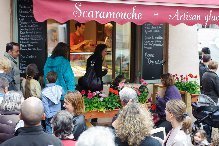
Scaramouche: Adventures in Ice Cream, opened in on April 26, 2013 in Cereste, France after a year of intense testing and much pillow talk about vanilla (not quite as sexy as it sounds).
 The idea came to us suddenly, Gwendal has always wanted his own business, his own space. We both wanted to share the extraordinary flavors we've discovered here in Provence, from the mellow sweetness of the local melons (harvested just down the hill) to the acid tang of sheep's milk yogurt (my new favorite flavor). I've learned how to make change (my mom was worried about me and the math) and homemade hot fudge. Gwendal's got a closet full of suits gathering mold and is happier than I've seen him in years.
The idea came to us suddenly, Gwendal has always wanted his own business, his own space. We both wanted to share the extraordinary flavors we've discovered here in Provence, from the mellow sweetness of the local melons (harvested just down the hill) to the acid tang of sheep's milk yogurt (my new favorite flavor). I've learned how to make change (my mom was worried about me and the math) and homemade hot fudge. Gwendal's got a closet full of suits gathering mold and is happier than I've seen him in years. 
The menu and the recipes came from both sides of the Atlantic. There's a traditional Banana Spilt, like the ones I used to share with my dad. There's a flavor called 1001 Nuits (1001 Nights), made with Raz-el-Hanout (traditional cous-cous spice) and grilled almonds - a nod to Gwendal's family's pied-noir roots in Morocco.
There are cultural differences, even in ice cream. Gwendal and I had a little tiff about the Strawberry. The French like strawberry sorbet, hot pink and smooth. I grew up with creamy pale pink strawberry ice cream with chunks of fruit. As so often happens in an intercultural marriage, we ended up doing both.
Our first summer season is winding down, but there are all the fall flavors to come: quince sorbet, pear sorbet, chestnut ice cream, butternut squash ice cream with sage. I want to add a maple syrup and candied pecan ice cream; we'll have to see how difficult it is to import proper dark maple syrup. You can follow along with all the new flavors on our facebook page.
 As the winter months set in, I'll get back to writing (and cooking) full time. My next book, Picnic in Provence is due in April 2014 (to be published in Spring 2015). In between, I'll be launching a new version of this site, and keeping up with the foodie photos on the Lunch in Paris facebook page.
As the winter months set in, I'll get back to writing (and cooking) full time. My next book, Picnic in Provence is due in April 2014 (to be published in Spring 2015). In between, I'll be launching a new version of this site, and keeping up with the foodie photos on the Lunch in Paris facebook page.PS. No one believe it, but Gwendal lost 20 pounds, I lost 10. I'm thinking of filming my own infomercial: LOSE 10 POUNDS IN TWO WEEKS: OPEN AN ICE CREAM SHOP.


Published on August 26, 2013 07:34
October 17, 2012
Uncanny: A Fig Chutney Lesson

Autumn is here, suddenly, vibrantly. The wind has pushed aside the summer haze. The sloping angles of the roofs against the sky are sharp, clear. Falling chestnuts are deadly (in a Bugs Bunny cartoon kind of way). My son has made a collection of the smooth dark globes, the perfect size for his small fist.
As the temperature drops, I slip into a mild culinary panic. The last of September's abundant figs, plums are disappearing - the quince, herald of a long winter's simmer, have arrived. All this makes me mourn. It also makes me realize that I've gone yet another busy summer in Provence without quite learning how to can.
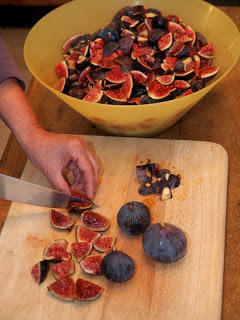
I thought a book might be helpful, but the books make the same assumption – that your mother, your grandmother and your grandmother’s grandmother have been making jam since time immemorial. A book is simply an aide-memoire for something already in your blood. Sure, my grandmother’s grandmother probably knew how to make jam, but somewhere on the journey from the shtetl to suburban New Jersey, we picked up Smuckers. The French recipes are patently unhelpful: Put one kilo of fruit and one kilo of sugar in a pot. Boil. Jar. They never say much about timing, temperature – or botulism.
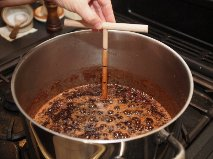 What I really needed was a masterclass. When in doubt, call a Brit. Mollie and David make their own jam and chutney in neatly labeled jars. I’d been politely bugging them about it since June. Like a singing lesson with Maria Callas, I thought I should sign up early. (See that neat little wooden gizmo to the left, that's a tool to spread crepe batter that David has handily converted into a measure to show him when the vinegar syrup has properly reduced - Clearly, I have a few tricks of the trade to learn.)
What I really needed was a masterclass. When in doubt, call a Brit. Mollie and David make their own jam and chutney in neatly labeled jars. I’d been politely bugging them about it since June. Like a singing lesson with Maria Callas, I thought I should sign up early. (See that neat little wooden gizmo to the left, that's a tool to spread crepe batter that David has handily converted into a measure to show him when the vinegar syrup has properly reduced - Clearly, I have a few tricks of the trade to learn.)
As I walked in the door, I was enveloped in the steam coming from the stove – the sharp edge of vinegar and fresh ginger softened by cinnamon and the sticky slow dissolving of the figs. Mollie and David’s kitchen is the stuff of dreams. There’s a rustic front kitchen with heavy beams, well scrubbed wooden counters and a groaning red range with room for six bubbling pots. Glass front cabinets with crystal tumblers, a shelf of neatly labeled spices in squat glass jars.
Hidden discreetly behind the stove is the doorway to their secret weapon - a smaller room, a full pantry, lined floor to ceiling with white cabinets, an extra freezer and a deep slop sink. It’s like Upstairs, Downstairs, but without the servants.
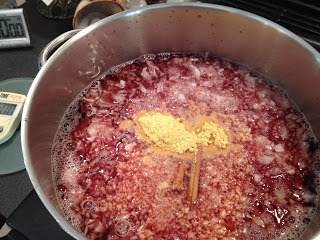
By the time I arrived they had the whole thing set up like a cooking show. (David is also a very skilled photographer - some of the photos are his). There was an almost finished pot bubbling on the stove. The glass jars (sterilized in the dishwasher) were sitting snugly in a large roasting pan, covered lightly with a paper towl to keep stray insects or dust from flying in. Just beside were all the ingredients for the next batch – ready to start all over again. Just like when Nigella Lawson shows you how to make a chocolate cake and then, it the name of instant gratification and a half hour time slot, whisks a finished one from the oven just as the other goes into bake.
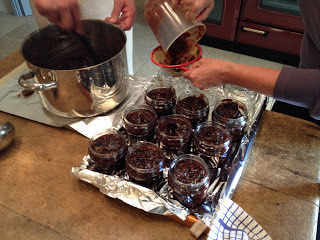
Mollie and David clearly had this down to a science. When the fig mixture was almost done, Molly placed the roasting pan full of jars in a 100C oven for 10 minutes. Using a silicone oven mitt, she transferred the hot jars onto a foil lined tray and got ready to pour. The chutney was thick, like the affectionate blob in a B horror movie. Big chunks of fig slid through her flowered ceramic funnel in satisfying gloops. Every once and a while a drip would escape. "Oh Bul" -, Mollie began, stopping herself. I saw one of David’s Dickensian eyebrows shoot up. "Normally," said Mollie, 'there is a fair bit of swearing during this bit, but having you here will keep us in line."
She quickly screwed the top on with a silicone oven mit."It makes the seal as it cools down, you see. I just tried to open one of last year’s in the pantry. Couldn’t loosen it."
While Molly was photocopying the recipe. I stared out the window of the office. The smell of a nearby pine drifted through the open window. I left the house, a warm pot of chutney in my hands, already dreaming of thick slices of sourdough bread and the butcher’s jambon aux herbes. "If you can bear the suspense." said David, "Leave it in the back of the cupboard for a few months. It’ll be that much better for Christmas.
Not sure I can wait that long...
Mollie and David's Fig Chutney
Though figs are a passion of mine, I suspect this would be equally good made with pears, quince, or even apples. With infinite thanks to M&D for sharing their recipe!
A note to time starved cooks: Chutney requires patience, though not constant supervision. Make sure you have a good 3-4 hours ahead of you when you start. An excellent rainy day activity.
Red wine vinegar 3.25 litres
Light brown sugar 1.125 kg
Onions (finely chopped) 5
Fresh root ginger (finely chopped) 150 – 200 gm (to taste)
Colman's mustard powder 5 tsp
Lemon zest 1.5 lemons
Cinnamon 2.5 sticks
Coarse Sea Salt 9 tsp
Allspice 1.25 tsp
Cloves (crushed) ½ tsp
Figs 3 kg, (quartered)
In a large saucepan (stainless or enamel) combine the vinegar, sugar, onion, ginger, mustard seeds, lemon zest, cinnamon stick, salt, allspice, and cloves and bring to a boil. Reduce the heat to a simmer and cook until mixture is thickened and reduced by 2/3, forming a thick syrup. (This will take a good 90 minutes - up to 2 hours.) Add the figs and cook gently until the figs are very soft and beginning to fall apart and most of the liquid they've given off has evaporated, about 30 minutes more.
Transfer the chutney to a non-reactive container and allow to come to room temperature before serving. The chutney may be made up to 3 weeks in advance and stored in the refrigerator in an airtight container.
(Alternately, hot chutney may be ladled into hot sterilized canning jars and processed in a hot-water bath according to manufacturer's directions.)
Makes around a dozen 340ml pots
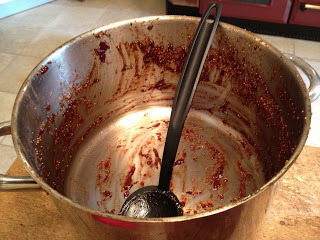

Published on October 17, 2012 19:05
September 13, 2012
A Perfect Storm
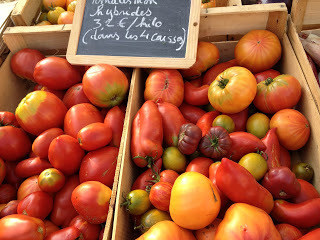
September is a perfect storm at my local market.
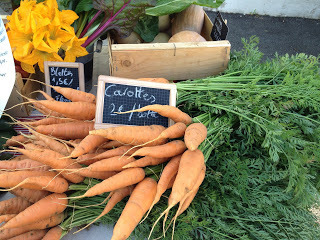
The tomatoes are out of this world. But then again, so are the carrots. And the beets. Summer and autumn smack into each other like student lovers who haven't seen each other since finals. The pairings are bountiful, a little wild, and above all - very short lived.
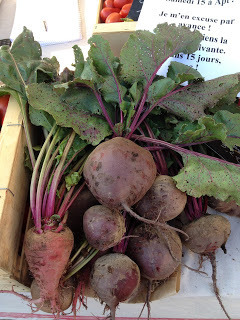
I don't need to do much to transform these fabulous ingredients. A little feta and olive oil.
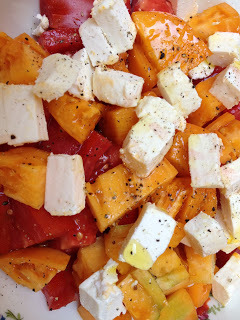
Garlic, and olive oil...

Herbes de Provence...and olive oil.

In France - anywhere, really - the first rule of being a great cook is being a great shopper. When you start with wonderful things, dinner mostly takes care of itself.
Sauteed Beet Greens with Garlic and Olive Oil
A great alternative to spinach or Swiss chard, I recently had my first experience with beet greens. I can't help but think of Italy when I make this - the Italians so favor humble greens that the French often overlook...
1 tablespoon olive oil
1 large clove of garlic, thinly sliced
beet greens from 3 or 4 large beets
Wash the greens in a colander, but do not dry them - you want a little water clinging to the leaves.
Heat the olive oil in a large frying pan (or wok), add garlic and saute for 30 seconds to 1 min, until the garlic is fragrant. Add the damp greens, stir to coat with olive oil. Cook 2 minutes uncovered, then cover partially and continue cooking until greens are tender (I actually like them slightly charred), 3-4 minutes more.
Serves 2 as a side dish
September Briam
Every year when G. and I come back from our solo week in Crete, I buy a cookbook in the airport. The recipes are approximate at best, but I'm desperate to recreate some of the pure tastes (not to mention the pure relaxation) of our time there.
Briam is basically a Greek ratatouille. It's a low stress version that bakes in the oven and makes it's own sauce. Like all dishes of this kind, the quality of the finished dish depends entirely on the veggies you start with. So hit the local farmers market and go crazy.
1 medium (or 2 baby) eggplant, cut into large chunks
2 red onions, cut into 8ths
4 carrots, halved lengthwise
3 zucchini (summer squash), 2 yellow, 1 green, cut into large chunks
1 small green pepper, cut into large chunks
2 large tomatoes, cut into 6ths
1 large tomato, for grating into the sauce
1/3 cup (79 ml) olive oil
1/3 cup (79 ml) water
1 tsp herbes de provence
1 tsp sugar
Generous sprinkle of coarse sea salt
Generous grinding of black pepper
Preheat the oven to 350F (180C). In a large casserole dish, combine the vegetables. Keep your pieces big, they will have plenty of time to cook through.
Cut your remaining tomato in half, and coarsely grate it on top of the other veggies. (When you grate your tomato, press the cut half towards the grater, and grate all the way down - then throw away the skin.)
Add the olive oil, water, herbes de provence, salt, sugar and black pepper. Mix everything together with your hands, until all the vegetables are coated with the liquid.
Cover tightly, bake for 90 minutes. Uncover - baste the veggies, but don't move them around, or you'll get mush. Bake uncovered for a further 30 minutes.
Serve hot or warm, use the slick olive oil tomato sauce left at the bottom for pasta the next day. Use leftover veggies and sauce to cook fish (the photo below is monkfish filet), or as filling for an omelet.
Serves 4-6 as a side dish.


Published on September 13, 2012 02:26
August 28, 2012
French Casual

My first experiences with French Cuisine (with a capital C, merci very much) were at Babette, a now defunct brownstone in Manhattan's theater district. The silverware was heavy, the ladies old and the calves brains sauteed in clarified butter. A certain formality still hovers over French dining. It's hard to shake the image of starched chefs, maniacal shallot chopping technique and maybe a baroque birdcage of spun sugar to enclose your single scoop of grapefruit-champagne sorbet. Oui, the French know how to lay out a 5-course dinner like no one else, but in Provence I've discovered a less formal repertoire -the dishes people bring to picnics, and serve with lingering evening aperitifs - savouring the last of the long summer sun.
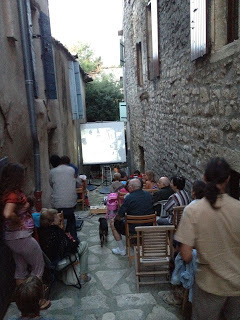
Our neighbor, Mr. C. (he of the cherry trees), brought these biscuits to a neighborhood picnic and outdoor film screening that we did on the terraced stone steps of the street just behind our house. The kids were up late, school's out after all. Young and old, old timers and city transplants mingled, drank wine and ate quinoa tabbouleh salad.
Mr. C's recipe is a savory cousin of the crumbly butter cookies that the French call sablés . Rich, perfectly balanced, they are what my British friends would call "moreish" - a succinct way of saying you could eat the whole batch in one sitting. The French, of course, would never do such a thing. Served with plump dates and a glass of roundish white wine, your Labor Day picnic might never be the same...
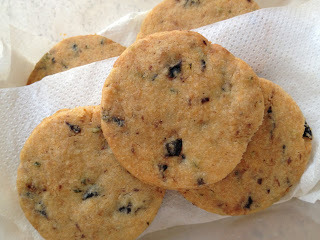
Mr. C's Rosemary Olive Sablé "Cookies"
These are extremely easy to make, provided your butter really is at room temperature when you start.
2 scant teaspoons fresh rosemary (approx an 8 inch branch), finely chopped
12 cured black olives, pitted and finely chopped
150 grams (10.5 tablespoons) unsalted butter
200 grams (1 1/4 cup) flour
150 grams (1 cup) grated Parmesan cheese
Black pepper
A hour or two before you want to bake, take the butter out of the fridge. It needs to be really soft.
Preheat the oven to 350F (180C). Line a large cookie sheet with parchment paper.
Chop the rosemary, pit and chop the olives, set aside.
In a large mixing bowl, with your hands, work together the butter, flour and Parmesan and a grinding of black pepper until a dough forms. Add the rosemary and olives, knead through to distribute evenly. On a piece of parchment paper, roll out the dough to about 1/4 thick. Using a cookie cutter (the top of a glass will also work), cut 2.5 inch rounds. You should have about 16.
Bake until highly colored, 15-17 minutes. Cool on a wire rack. The "cookies" keep nicely in an air-tight container for 2-3 days - if they last that long...
Makes 16 cookies.

Published on August 28, 2012 14:08
July 29, 2012
A Big Bite of Summer
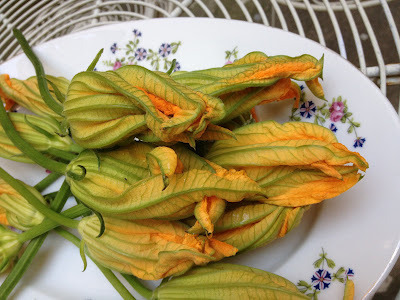
Summer cooking in Provence does not leave a lot of room for free will. Exceptional ingredients come in tidal waves; no sooner have you finished gorging yourself on cherries in June than it's all melon, all the time.
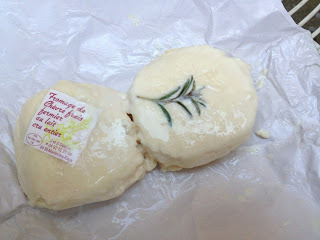
My favorite of the recent culinary tsunamis are the zucchini flowers. Beautiful, delicate, with a surprisingly intense flavor, they are often simply fried and served as "beignets". I prefer to stuff them - goat cheese and fresh mint from our garden, beef with wild rice, tomato and feta, "brousse de brebis" (our local ricotta) and green olive tapenade.
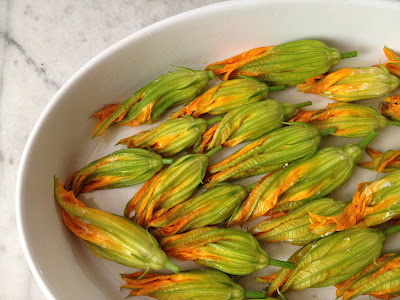
I like to serve them before the meal. A teaser, really. There is something about biting into a flower that surprises, then delights, my guests. They are so good right out of the oven that this food blogger actually forgot to take a picture of the finished product. My husband, who hasn't eaten hot food in three years, can tell you how rare that is...
Wishing you a big bite of summer!
Zucchini Flowers Stuffed with Goat Cheese and Fresh Mint
Like so many of the best French dishes, this recipe highlights one or two exceptional seasonal ingredients with a minimum of fuss.
3 oz. fresh goat cheese
1 egg
2 tablespoons fresh mint, finely chopped
1/2 teaspoon fennel seed
Salt, pepper to taste
Extra virgin olive oil
Heat your oven to 350F (180C).
Lightly beat the egg, crumble in the goat cheese, and mash together with a fork. And mint, fennel seeds and salt and pepper to taste.
Stuff the flowers (don't rinse them first, but be sure to check for ants hiding inside!). Twist to close.
In a large casserole dish, pour in a small amount of olive oil. Roll each flower in the oil until lightly coated.
Bake for 15-20 minutes until lightly browned and fragrant.
Serves 2 as an appetizer, 4 as an amuse bouche.
Tip: You'll probably find zucchini flowers at your local farmer's market - unfortunately, they are too delicate for the supermarket.

Published on July 29, 2012 07:27
June 26, 2012
30 Minute Meal

Thursday is fish day at our house - that's when my fishmonger (that's him) comes to our local market. Home cooks tend to see fish as a major production - something best ordered in a restaurant - but if I were to write one of those "30-Minute Meal" cookbooks, there would probably be more fish recipes than anything else.
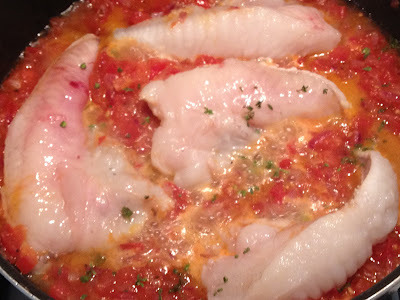
Here's a quickie one-pan dinner using the the emerging summer flavors of Provence. The tomatoes are just arriving, and peas, well - I can't get enough of Provencal peas. My herb garden is in grand form at the moment - so I added the flowering portion of my lemon verbena plant, a bit of lemon basil and some lemon thyme. I recently bought some dried Spanish Nora Peppers, very mild, a little smoky, like good paprika. I've been adding a pinch or two to my tomato bases. Gives it a subtle bass note.
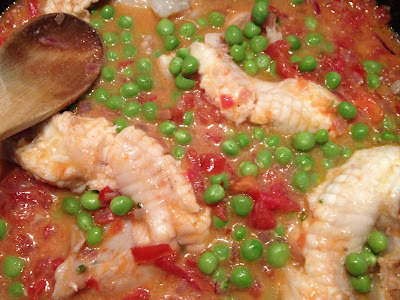
Monkfish Fillets with Tomatoes and Fresh Peas
4 monkfish fillets
2 tablespoons olive oil
1 small red onion, diced
3 medium vine-ripened tomatoes, chopped
1/2 tsp sugar
1/3 cup white or rose wine
2 large pinches of dried Spanish Nora peppers or good paprika
1 tsp fresh lemon thyme (or the flowering portion of lemon verbana or lemon basil) -regular thyme + a bit of lemon zest would do
salt and pepper to taste
1 cup fresh peas
Heat olive oil in a good size frying pan. Saute onion until translucent, 4-5 minutes. Add chopped tomatoes and sugar, simmer 5 minutes. Add wine, simmer 3 minutes more. Add Nora pepper or paprika, stir to combine. Add fish fillets and thyme. Cover and simmer on medium-low for 10-15 mintues, turning the fillets once midway through. Cooking time will depend on the size of your fillets - start checking early. Be gentle - monkish, when properly cooked, has a nice firm texture like lobster, you don't want to boil it to mush.
When the monkfish looks nearly done, stir in the fresh peas and heat through - about 2 minutes. Serve with quinoa or crusty bread to soak up the sauce.
Serves 4


Published on June 26, 2012 08:43
May 15, 2012
A Salad of Many Virtues
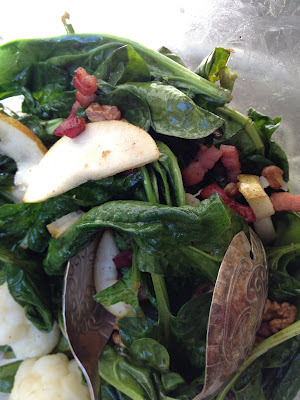
I remember it like it was yesterday: the day I learned that French salad is not diet food. A salad in France is a happy meal - not some thrilless plate of virtue that leaves you wishing you'd ordered the blooming onion. G. took me to a Chez Gladine, a student hole in the wall in Paris, in the villagey quartier of the Buttes-aux-Cailles. There were shared tables with red checkered clothes, hundreds of bumper stickers on the mirrored back wall. But what made the biggest impression was the salad - it was served in a huge crockery bowl -instead of iceberg with When-Harry-Met-Sally sauce on the side, I dove into a world of bumpy, ruffled, mustard and olive oil slicked feuille de chêne lettuce, chucks of roasted potatoes, qartered tomatoes, comté cheese, seared chicken livers, dried duck gizzards, and of course, waiting at the bottom, just to see if I'd get there, crispy lardons - the bacon bits that changed my life forever.
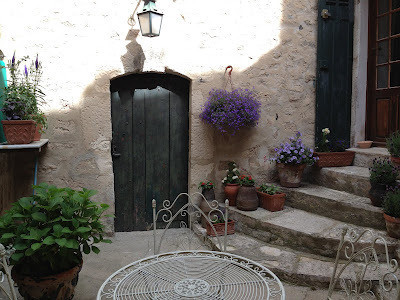
We are in mi-saison in Provence at the moment, which means that one day you need your sunscreen, the next day you want to light your wood burning stove. We've begun eating outside in our newly gussied up courtyard; the bees are louder than helicopters. A salad that mixes hot and cold, sweet and savory, is my perference for this time of year.
Wash and pat dry a few generous handfuls of fresh spinach, stems and all. (I know what you're thinking, but the perfectly calibrated baby leaves, pre-washed and sold in the plastic bag in Shoprite probably won't stand up to what I have in mind...)
In a large frying pan, fry up 8 oz. of lardons, or diced slab bacon. When the bacon has rendered it's fat and begun to crisp up, add a generous handful of whole walnuts. Stir until coated and crisp - about 1 minute more. Shut the heat. With a slotted spoon, remove the bacon and walnuts to a seperate dish. Put your washed spinach leaves into the warm pan and stir to coat with the bacon fat. Add a teaspoon of olive oil, a generous pinch of sea salt, a teaspoon of balsamic vinegar and a good grinding of pepper. Toss the whole lot, right there in the pan.
In a large salad bowl combine the spinach, bacon, walnuts and top with a thinly sliced pear. Serve with whole grain bread and Morbier or an aged goat's cheese.
Serves 2 as a main course or 4 as an appetizer. Bon appetit!

Published on May 15, 2012 05:40
April 19, 2012
Let Them Eat Cake?

So this is why I pay my taxes. A. (and 20 other kids) had their "gouter" - that's French for afternoon snack - at the new village creche that he will attend as of next week. State subsidized daycare (from the age of 8 weeks) and the right to full day pre-school (every child over the age of 3) are the fundamental secrets of low stress French parenting. Simply put, the kids are out of the house a lot longer, and a lot earlier, than in the US. Funny, I was just starting to get the hang of being a mom (now that A. and I can have a conversation about Dr. Suess), and now he's going to forge his own way in the plastic playhouse - as he should.
My mom remembers my first day of school very clearly. Me walking down the flagstone path, Mary Janes on my feet, plastic lunchbox in hand. Now I know why. A. is out in the world now, and if I do my job right - if he spreads his wings as I hope he will - he's never coming back (except for rice pudding and laundry - and hopefully, the occasional bit of advice).
Thoughts of his future girlfriends and career in extreme sports aside, my immediate concern yesterday was to keep my son from giving his American roots a bad name by eating too much cake. He actually gets his love of cake from his French father, but where cultural stereotypes are concerned, you can never be too careful.

Published on April 19, 2012 02:55
April 14, 2012
Backseat Driver

Holy Empire State Building, Batman. I've just been taken for a tourist in the city of my birth.
Going home, back, back, home (whatever) to New York is getting confusing.
After a week at my parent's new place in Delaware, G and I walked out of Penn Station into the concrete soaked sunshine. I sucked in the noise and the car exhaust like the air at the top of Everest. Gwendal started to veer toward the 40 person taxi line. Un-uh, I said, and walked 25 ft up the block and into the middle of traffic to catch one that has better things to do with his time then wait in the taxi line at Penn Station.
We hoisted our suitcase and two large shopping bags of French liqueurs (samples for a friend) into the back. 149 West 10th Street I said. He nodded. G. and I were talking for 5 minutes before I looked out the window and noticed that we were at Amsterdam and 66th Street.
Excuse me. But why are we going uptown.
I thought you said 10th Avenue and Amsterdam. (Never mind that this is physically impossible.)
10th Street. I said, 10th Street. Sir, I'm not a tourist. You heard me perfectly well. Please reset the meter to zero and take us downtown.
And that's exactly what he did - but not before my pride was wounded, an identity crisis ignited, and a 1/2 hour lost that I could have spent in my favorite hat store in Soho.
When we got out of the cab, Gwendal looked at me like I had just peeled off my face. Do you think he was really trying to cheat us, or he just didn't speak English very well?
Doesn't matter, I snapped. And it didn't. The damage was done. Somewhere during my ten years in France, I crossed a line. New York is in my blood, but something else is in my voice, my hair, my clothes, and the fact that I now have to carry a suitcase out of Penn Station. Merde.

Published on April 14, 2012 12:02
April 5, 2012
The Back of the Cupboard

My mother's kitchen cupboards are full of good memories. I'm back in the US for Passover, and yesterday we made my grandma Elsie's mandel bread (toasted chocolate chip-walnut biscotti), a family favorite. When it was time to chop the walnuts, I paused. I could have used the mini food-processor on the counter (never get the bleeping cover on straight), but what did I find at the back of the closet but grandma's ancient glass chopper.
It's been 25 years since I saw my grandfather sitting at the kitchen table, with his engineer's concentration, pulverizing nuts with one good hand (the other damaged by a stroke). This year my son took a turn, pushing down the spring activated plunger onto the round wooden base. I love that about the holidays; the repetition of ingredients and recipes makes the years and the generations blur together - everyone makes an appearance, if only in my head.
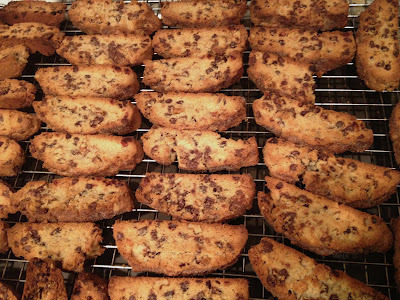
It would take superhuman powers to wait till dinner to taste them. I'm owning up to the nibbled one in the photo...
Grandma Elsie's Passover Mandel Bread
A non-Passover version of this recipe (which uses oil instead of butter and regular flour instead of matzo-meal) is given at the end of Chapter 10 of Lunch in Paris. Though I could eat the Passover version all year round.
2 cups sugar
1/2 lb. butter (two sticks)
6 eggs
2 and 3/4 cups matzo cake meal
1/2 tsp salt
3/4 cup potato starch
8 oz. mini chocolate chips
1 cup chopped walnuts
1 tsp cinnamon
2 tsp sugar
Preheat oven to 350F. Cream sugar and butter together in a large mixing bowl. Add eggs, one by one, beating after each addition. In another bowl, sift together matzo cake meal, salt and potato starch. Fold dry mixture into wet ingredients.
Add chocolate chips and nuts, mix to combine.
Line a large cookie sheet with tin foil, form dough into two flattish loaves, approximately 2 inches wide. Sprinkle with cinnamon and sugar. Bake for 45 minutes on center rack. Let cool for 10 minutes, then slice. Lay the slices out on baking racks, put back in the oven and toast until golden brown - 10 minutes on each side.
Serves 8-10. Freezes beautifully.

Published on April 05, 2012 18:34
Elizabeth Bard's Blog
- Elizabeth Bard's profile
- 313 followers
Elizabeth Bard isn't a Goodreads Author
(yet),
but they
do have a blog,
so here are some recent posts imported from
their feed.



